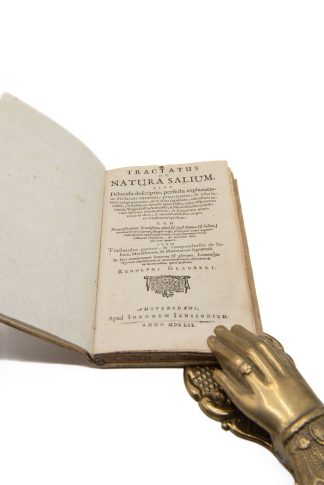GLAUBER, Rudolph.
GLAUBER’S SALT
Tractatus de natura salium. [with] Tractatus de signatura salium, metallorum et planetarum.
Amsterdam, J. Jannson, 1659.£1,650.00
FIRST LATIN EDITION of first. 8vo. 2 works in 1, separate titles, I: pp. [16], 96; II: pp. 44. Roman letter, little Italic. Title vignettes, small diagram with alchemical symbols to A4 (II), decorated initials. Slight toning, decreasing light water stain to lower outer corner, tiny worming to upper outer blank corner from gathering G onwards. A good copy in C17 vellum over boards, front eps renewed, the odd early ms marginal note.
A good copy of the first Latin edition of this important work on salts and minerals, and their nature and properties. The German chemist and alchemist Rudolph Glauber (1604?-68?) ‘is probably best remembered for the salt named after him (Glauber’s salt). His chemical and pharmaceutical philosophy was much like that of Paracelsus […]. But he was a keen observer and experimenter, keeping reliable records, which assured him a place among the pioneers of technical chemistry’ (Heirs of Hippocrates). First published in German the previous year, ‘Tractatus de natura salium’ contains the first account of Glauber’s salt, i.e., a sodium sulfate now called ‘mirabilite’, available to a wider, non-German-speaking readership. After a preface-advertisement summarising Glauber’s publications, it begins with a survey of the historical and biblical significance of salts, quickly moving to their alchemical properties in relation to the four elements, and the various kinds of salts: e.g., saltpeter, ‘sal fixum’, and his own ‘sal mirabilis’. Of the latter, used as a purgative and anti-inflammatory, he also provides instructions for its preparation, information on its appearance, odour, flavour and colour, and a survey of its uses together with other minerals and salts as well for medical remedies. Glauber provides similar instructions for other preparations of his own making, e.g., ‘leo viridis’, ‘vitriolum solis’ and ‘sal aureus mirificus’. The second work, first published separately in 1658, focuses on the way in which the ultimate essence of metals and salts finds expression in their appearance and is interpreted graphically, linguistically and symbolically, as well as the connections between minerals and the planets and their properties. For several salts, Glauber provides descriptions of their crystals as seen under the microscope: e.g., those of ‘fixus liquor nitri’, obtained after the substance is left long exposed to air, ‘are star-shaped’, with six corners, while vitriol and alum always develop in unequal shapes. An important work in the history of chemistry.
Krivatsy 4811; Duveen 257; Ferguson I, 327 (later ed.); Wellcome III, p.124; Osler 2752. Not in Heirs of Hippocrates.In stock






